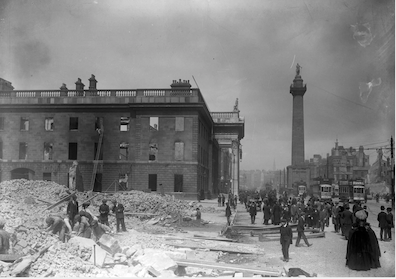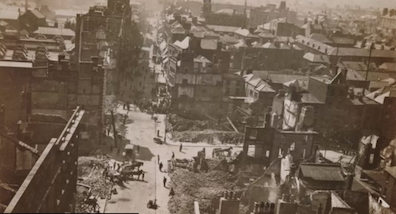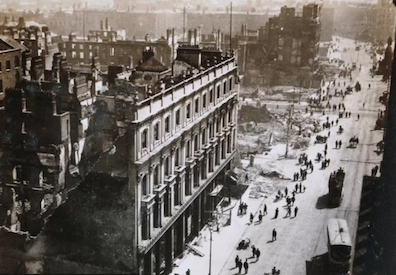In Nestor, when Stephen thinks of Blake's
vision of "the ruin of all space" and time, he imagines
"shattered glass and toppling masonry"––an image which does
not come from Blake's writings. This is no generic fantasy of
what apocalypse would look like to a city-dweller. In Proteus
Stephen links it with a specific event: the Fenian
bombing of the back wall of London's Clerkenwell prison
in 1867. This event has clear relevance to Stephen's
historical meditations in Nestor, so it is reasonable
to assume that he is thinking of it in both chapters. But
there is more. For Dubliners reading the novel in the late
1910s and early 20s, the words would certainly have called up
a much fresher memory: the catastrophic destruction visited
upon their city by the Easter Rising of 1916. Joyce must have
intended for his readers to make this proleptic connection.
The Clerkenwell bombing was designed to free a man held in
the prison but it badly damaged nearby homes, killing a dozen
people and injuring ten times that many. The London press
described it as an unparalleled atrocity, and the resulting
outcry imperiled Irish hopes for Home Rule for a generation.
It makes sense that Stephen would think of this bold but
counterproductive action in connection with the "excess" of
Blake's apocalyptic vision and with the despair of his own
vision of history as a nightmare. Channeling the
optimism of the French Revolution, Blake sees violence as a
window onto the "Last Judgment"––divine transfiguration.
Oppressed by seven centuries of English domination, Stephen
cannot separate that apocalyptic yearning from awareness of
repeated futility.
After April 1916 this dialectic of hope and despair was writ
large on the face of Dublin. The abortive revolution
ultimately changed public opinion, making militant
republicanism more attractive than incremental parliamentary
reform. In Easter, 1916 William Butler Yeats described
how the political landscape was "Transformed utterly: / A
terrible beauty is born." But in the near term the Rising was
an unmitigated disaster. In the course of one week it
destroyed much of the inner city while achieving nothing.
After republican fighters seized and barricaded key buildings
like the General Post Office, City
Hall, and the Four Courts, the British
Army mobilized soldiers in its many barracks around Dublin, used Kingsbridge
Station to bring in men and materiel, shipped
reinforcements into Kingstown Harbour, and
floated a gunboat up the Liffey. The GPO was easily within
range of the Helga's 12-pound guns and was destroyed
by heavy shelling, including incendiary shells which not only
gutted the interior of the post office but spread fire to
nearby buildings on Sackville Street, Henry Street, Abbey
Street, and Eden Quay. Artillery fire from field guns deployed
at Trinity College hammered other buildings occupied by rebel
forces.
To represent or explicitly mention these events in a novel set
in 1904 would have violated Joyce's commitment to scrupulously
realistic fiction, but various details in the novel show that
he was willing to evoke coming events in more covert ways. In
Nestor he made the boys' hockey game anticipate
the slaughters of the Great War that was raging at the
same time as the Rising (1914-18). In Eumaeus numerous
references to blocks of ice, sharp lookouts, and
maneuvering ships evoke the 1912
sinking of the Titanic. In Cyclops characters
mention, and walk by, the spot on Arbour Hill where inciters
of the 1798 Rebellion were executed––a spot also strongly
associated in Irish popular memory with the burial of 14
executed republicans in 1916.
This pattern of proleptic foreshadowing makes it entirely
plausible that Joyce intended for "shattered glass and
toppling masonry" to evoke the piles of masonry that
confronted Dubliners after the Rising. Indeed, it would have
been remarkable for him not to think of the city he
loved being reduced to rubble while writing Nestor in
1916 and 1917. His famous hyperbolic remark that "If Dublin
were to be destroyed Ulysses could be used to rebuild
it brick by brick" no doubt expressed his vivid awareness that
on one occasion many of the city's best-known buildings had in
fact toppled into piles of bricks. The detail that comes next
in Nestor––"and time one livid final flame"––may
have had its genesis in Blake's belief that "The world will be
consumed in fire at the end of six thousand years," but it
also seems to refer to the violent blaze that consumed the
General Post Office and buildings all around it. Records of
the Clerkenwell explosion do not mention any such inferno. In
Circe Joyce combines Blakean apocalypse and Dublin
catastrophe one last time as Stephen attempts to bring the
curtain down on his private cosmos: "He lifts his ashplant
high with both hands and smashes the chandelier. Time's
livid final flame leaps and, in the following darkness,
ruin of all space, shattered glass and toppling masonry."
But even if the author did not intend for his words to be read
in this forward-looking way readers would still be justified
in doing so, because the implications of the history mesh so
perfectly with the patterns of the fiction. The Easter Rising
made one more in the long string of defeats and Pyrrhic
victories that discourages Stephen in Nestor,
and at the same time it effected a Blakean transfiguration,
convincing the mass of Irish people that independence was
finally at hand. Stephen hears in the collapse of buildings
the apocalyptic ruin of space and time, while thinking also of
the human cost: "What's left us then?"





